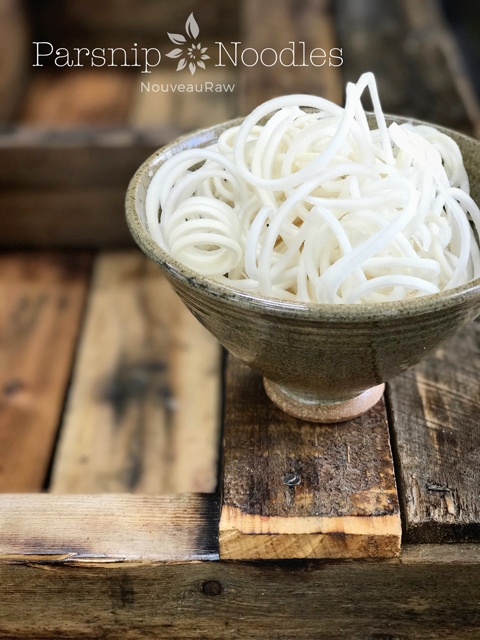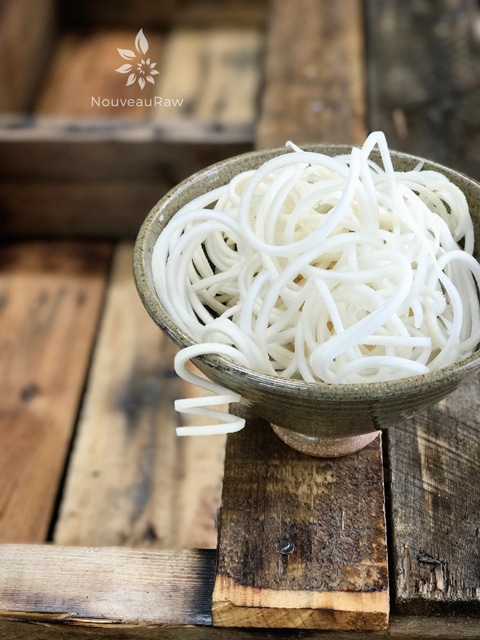Parsnip Noodles

 Add to favorites
Add to favorites

~ raw, vegan, gluten-free, nut-free, alkaline ~
The parsnip plant has a thick fleshy root that is whitish or yellowish in color and is related to the carrot. But they are sweeter and sharper in flavor than a carrot.
The core of the parsnip can be woody and bitter in taste which with this application is perfect because the spiralizer will keep the core of the parsnip intact and can be composted after the noodles are made.
Health Benefits
When researching the health benefits of parsnips, I read that eating parsnips can stimulate growth in children. Aaaand, since I have never really grown up and I am vertically challenged… I just might be increasing my consumption of parsnips. Hehe If that isn’t a very realistic approach I guess I will continue to enjoy them anyway.
They are known to reduce constipation encouraging regular bowel movements and proper functioning of the liver. They also have soluble fiber in them which can help regulate blood sugar levels and lower cholesterol. (source for more health benefits)
Select fresh, firm, fleshy, medium size, even surfaced parsnips. Ideally, they should be 6-8 inches long, avoid if pitted, knobby, or have damaged roots. You can store parsnips in a plastic bag in the vegetable drawer of the fridge.
 Ingredients:
Ingredients:
Preparation:
- Be sure to pick the freshest, in season, parsnips that you can find. This will ensure that you get the best tasting noodles possible. Select the largest parsnips in diameter.
- Look for firm parsnips. If the flesh is soft or rubbery, it won’t work in the spiralizer.
- With a potato peeler, remove the skin and trim the ends.
- Place the unit on the countertop and press down on the spiralizer to engage the suction cups and secure.
- Insert the blade cartridge you’d like to use, make sure that it clicks into place.
- Cut the parsnips into 4-6” length pieces.
- Place the center of the parsnips onto the cylinder part of the blade and press the teeth of the handle into the other side of it.
- Take hold of the handle on the bottom (the horizontal one) with one hand and then spin the handle with the teeth to spiralize. Press steadily with forward pressure, using the handle that you’re gripping, for best results.
- Before dressing up the noodles, take scissors when you’re done spiralizing and cut the noodles into manageable sized pieces. Just grab a bunch of noodles and roughly snip. Or enjoy that never-ending noodle!
- You can make noodles in advance, they should keep for 5-7 days in the fridge, without sauce.
To clean the spiralizer:
- Purchase an inexpensive handled brush for cleaning the blade parts and hard to reach parts on the unit. This will save your fingers and prevent nicks from happening on the blades, keeping them nice and sharp.
- Be sure to quickly rinse the unit after creating noodles. The juices from certain root veggies can stain the unit.
- Dry the blades well before putting them away.
Tools used to create noodles:
GEFU Spiralfix Spiral Slicer
- Can be used in the left or right hand.
- 4 different widths of cut for creative recipes: Spiral cut across the entire width of the material, 3 mm, 6 mm, or 12 mm wide adjustable via adjusting wheel
- Folding lid for easy filling
- Detachable non-slip holding container for safe standing
- Material: stainless steel, ABS plastic, SAN
- Splash-guard lid with drive unit detachable for easy cleaning. Dishwasher-safe
Spiralizer 7-Blade Vegetable Slicer
- This slicer comes with 7 different blades which give you 7 completely different textures and shapes.
- Comes with 420 high carbon cutlery grade stainless steel blades and stronger making it possible to Spiralize harder root vegetables like sweet potatoes and turnips that previously broke Spiralizer handles
Potato Peeler
- Wash and peel the outer skin off of the veggie.
- Hold the veggie at one end and in a long stroke motion, run the peeler from top to bottom.
- Rotate the veggie in a circular motion and continue peeling until you reach the seeded core (if there is one). Stop once you reach this. Don’t throw it away, use it in a smoothie or salad.
© AmieSue.com
Tags: Alkaline, Dairy Free, Gluten Free, No Dehydration Required, Nut Free, Refined Sugar Free, sugar free, Vegan



 Add to favorites
Add to favorites
 Ingredients:
Ingredients:
I love zucchini noodles and have prepared them with both marinara and pesto. Do you have sauces for these other veggies?
Working on more recipes Gail… I have many sauce like recipes under “main and side dishes” category that would be great on veggie noodles… check there for ideas. :) Have a great weekend! amie sue